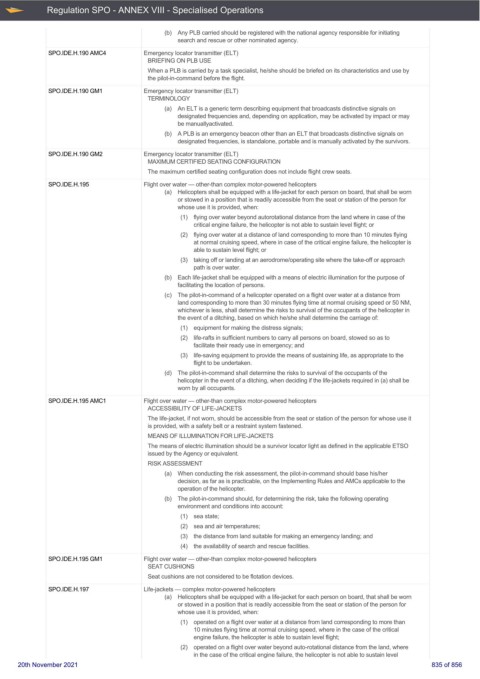Page 835 - UK Air Operations Regulations 201121
P. 835
~
~ Regulation SPO - ANNEX VIII - Specialised Operations Centrik
(b) Any PLB carried should be registered with the national agency responsible for initiating
search and rescue or other nominated agency.
SPO.IDE.H.190 AMC4 Emergency locator transmitter (ELT)
BRIEFING ON PLB USE
When a PLB is carried by a task specialist, he/she should be briefed on its characteristics and use by
the pilot-in-command before the flight.
SPO.IDE.H.190 GM1 Emergency locator transmitter (ELT)
TERMINOLOGY
(a) An ELT is a generic term describing equipment that broadcasts distinctive signals on
designated frequencies and, depending on application, may be activated by impact or may
be manuallyactivated.
(b) A PLB is an emergency beacon other than an ELT that broadcasts distinctive signals on
designated frequencies, is standalone, portable and is manually activated by the survivors.
SPO.IDE.H.190 GM2 Emergency locator transmitter (ELT)
MAXIMUM CERTIFIED SEATING CONFIGURATION
The maximum certified seating configuration does not include flight crew seats.
SPO.IDE.H.195 Flight over water — other-than complex motor-powered helicopters
(a) Helicopters shall be equipped with a life-jacket for each person on board, that shall be worn
or stowed in a position that is readily accessible from the seat or station of the person for
whose use it is provided, when:
(1) flying over water beyond autorotational distance from the land where in case of the
critical engine failure, the helicopter is not able to sustain level flight; or
(2) flying over water at a distance of land corresponding to more than 10 minutes flying
at normal cruising speed, where in case of the critical engine failure, the helicopter is
able to sustain level flight; or
(3) taking off or landing at an aerodrome/operating site where the take-off or approach
path is over water.
(b) Each life-jacket shall be equipped with a means of electric illumination for the purpose of
facilitating the location of persons.
(c) The pilot-in-command of a helicopter operated on a flight over water at a distance from
land corresponding to more than 30 minutes flying time at normal cruising speed or 50 NM,
whichever is less, shall determine the risks to survival of the occupants of the helicopter in
the event of a ditching, based on which he/she shall determine the carriage of:
(1) equipment for making the distress signals;
(2) life-rafts in sufficient numbers to carry all persons on board, stowed so as to
facilitate their ready use in emergency; and
(3) life-saving equipment to provide the means of sustaining life, as appropriate to the
flight to be undertaken.
(d) The pilot-in-command shall determine the risks to survival of the occupants of the
helicopter in the event of a ditching, when deciding if the life-jackets required in (a) shall be
worn by all occupants.
SPO.IDE.H.195 AMC1 Flight over water — other-than complex motor-powered helicopters
ACCESSIBILITY OF LIFE-JACKETS
The life-jacket, if not worn, should be accessible from the seat or station of the person for whose use it
is provided, with a safety belt or a restraint system fastened.
MEANS OF ILLUMINATION FOR LIFE-JACKETS
The means of electric illumination should be a survivor locator light as defined in the applicable ETSO
issued by the Agency or equivalent.
RISK ASSESSMENT
(a) When conducting the risk assessment, the pilot-in-command should base his/her
decision, as far as is practicable, on the Implementing Rules and AMCs applicable to the
operation of the helicopter.
(b) The pilot-in-command should, for determining the risk, take the following operating
environment and conditions into account:
(1) sea state;
(2) sea and air temperatures;
(3) the distance from land suitable for making an emergency landing; and
(4) the availability of search and rescue facilities.
SPO.IDE.H.195 GM1 Flight over water — other-than complex motor-powered helicopters
SEAT CUSHIONS
Seat cushions are not considered to be flotation devices.
SPO.IDE.H.197 Life-jackets — complex motor-powered helicopters
(a) Helicopters shall be equipped with a life-jacket for each person on board, that shall be worn
or stowed in a position that is readily accessible from the seat or station of the person for
whose use it is provided, when:
(1) operated on a flight over water at a distance from land corresponding to more than
10 minutes flying time at normal cruising speed, where in the case of the critical
engine failure, the helicopter is able to sustain level flight;
(2) operated on a flight over water beyond auto-rotational distance from the land, where
in the case of the critical engine failure, the helicopter is not able to sustain level
20th November 2021 835 of 856

